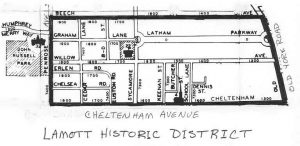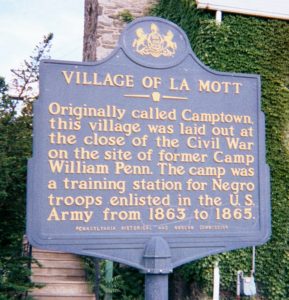Cheltenham has two districts listed on the National Register of Historic Places. The first district, La Mott was added to the Register on October 31, 1985 and has 35 properties. The second district, Wyncote was added on October 16, 1986 and has 178 places. La Mott is in Cheltenham Township bordering Philadelphia along Cheltenham Avenue.
In 1850, Cheltenham Township was comprised primarily of large Quaker farms, mills and country estates. Edward M. Davis, a real estate entrepreneur joined his brother-in-law, at Oak Farm, an estate located along Old York Road. Like his mother-in-law, Lucretia Mott, Davis embraced Quaker tenets, and was a zealous abolitionist participating in the Anti-Slavery Society and Non-Resistance Movement.
The abolitionist philosophy of equality among the races carried over into Davis’ business. Davis foresaw the future value of the land, and in 1854, and formed Chelten Hills Association to buy and develop real estate in Cheltenham Township. In the first year Chelten Hills Association purchased 1,000 acres of farmland, and sold off large parcels to wealthy Philadelphia entrepreneurs and merchants like Jay Cooke and John Wanamaker.
In 1857, Lucretia Mott and her husband joined their family at Oak Farm and retired to ROADSIDE, an old caretaker’s residence on the grounds of the farm. Lucretia Mott’s city residence, at 338 Arch Street, became the center for the Anti-Slavery Movement in Philadelphia and was the site of numerous meetings and rallies. Mott was active in the abolitionist movement, opening Roadside to slaves traveling the Underground Railroad to freedom in Canada.
In 1863, Cheltenham became the focus of national attention when it was chosen as the site of the country’s first recruiting and training camp for black soldiers. Blacks had served in times of war, but Section 2 of the Militia Act of July 17, 1862 was the first federal law allowed the president to call black soldiers to military service. Camp William Penn was established to train black volunteers. Eleven regiments were trained at the camp.
Lt. Col. Louis Wagner, a veteran of the Battle of Bull Run, was the camp’s commanding officer. Black regiments mustered at Camp William Penn were the 3d, 6th, 22d, 24th, 25th, 32d, 41st, 43d, 45th and 127th. The first location on Church Road was on the property of Civil War financier and abolitionist Jay Cooke, but moved to more level ground within three months time. Davis donated the new site west of Sycamore Avenue.
Cheltenham welcomed the black recruits. The Quaker and abolitionist residents offered the young men friendship, and moral support conducting Bible classes and sermons on the campgrounds and providing accommodations for visiting families. Lucretia Mott, then 70, delivered numerous inspirational speeches and sermons to the men; entertaining the officers at her home. Through these activities, Mrs. Mott became the unofficial spiritual leader to the black troops stationed at Camp William Penn.

At the close of the Civil War, Davis resumed his real estate development and purchased more land adjoining his land and then he re-purchased most of the 30 acres sold off before the war and began developing this area for residential construction and created La Mott Village.
In the first decades of the area’s growth, few black settlers owned property. George Henry is recorded as the first black landowner in the village, purchasing a lot on School Lane in 1868. Black residents began to take a leading role in the village’s development including brick maker William Watson who purchased land along Cheltenham Avenue. In 1879, longtime resident William Butcher finally purchased the stone house he had rented from Edward M. Davis, as well as several adjacent properties. Butcher then rented out the latter, becoming in effect, the first major black real estate investor in La Mott.

LaMott was listed on the National Register of Historic Places in 1985. Text below was adapted from a copy of the original nomination document.
The village of La Mott, located in Cheltenham Township, Montgomery County, Pennsylvania, stands as an important landmark in American black history. As one of the first communities in the country to embrace integrated living, the village represents a turning point in the social and racial development of residential enclaves in the post-Civil War era. Situated on a portion of the site of the nation’s first training camp for the Third Regiment of the U.S. Colored Troops (1863-1865), La Mott saw the participation of both blacks and whites in the development of this suburban residential community.
Much of the credit for the creation of this community is given to Lucretia Mott, noted Quaker abolitionist and suffragette, whose beliefs in racial harmony and equality were well known to the proponents of the anti-slavery movement While Mrs. Mott served as a spiritual leader, it was her son-in-law Edward M. Davis who was responsible for much of the physical development of the community. Davis, also a member of the Society of Friends, was a major landholder and real estate entrepreneur in Cheltenham Township. Shortly after the Civil War, Davis subdivided 30 acres of his land, cut streets and created small building lots available to both black and white purchasers. While the first purchasers were Irish immigrants, blacks soon began to acquire lots and build houses. From this the village of La Mott was born. Integration within a residential setting, even in the more enlightened northern industrial cities, was virtually unheard of in the nineteenth century, making Davis’ willingness to provide blacks and whites with an equal opportunity to purchase land progressive and enlightened in its foundations.
This tradition of racial harmony reflects the egalitarian beliefs of the architects of this unique community.honor Named in of one of the community’s most influential proponents, the Village of LaMott has created a rich heritage and standard for living which continues today.

